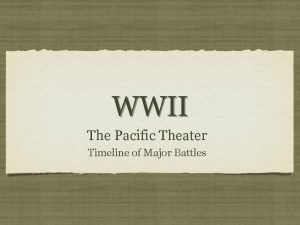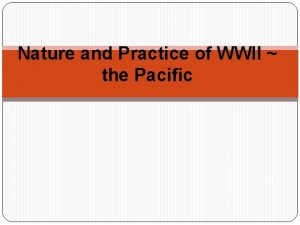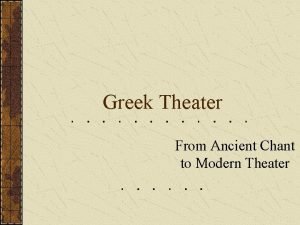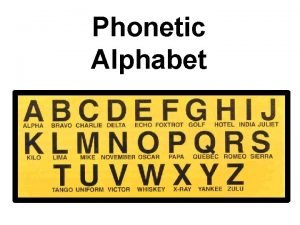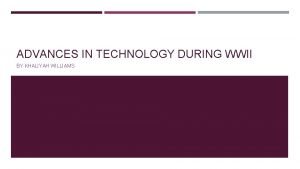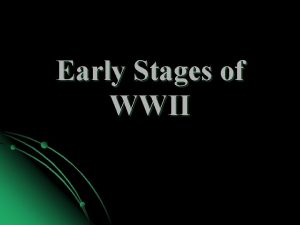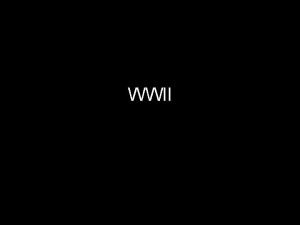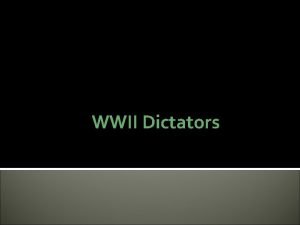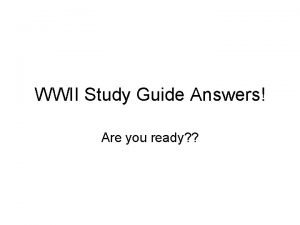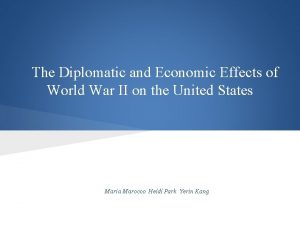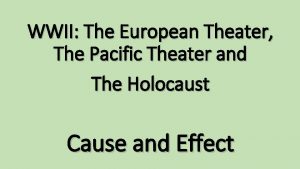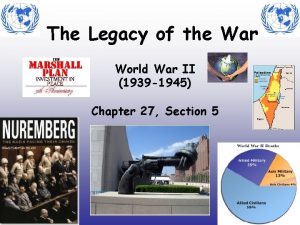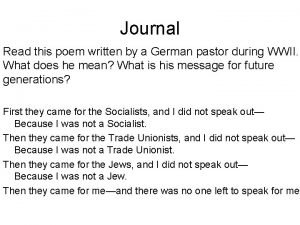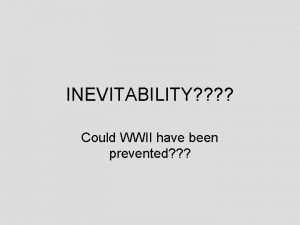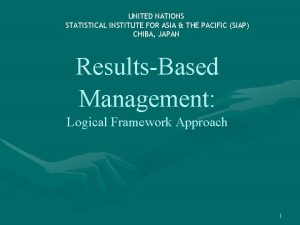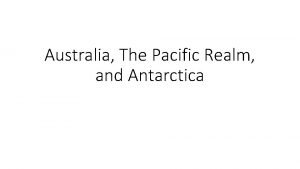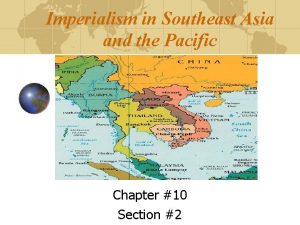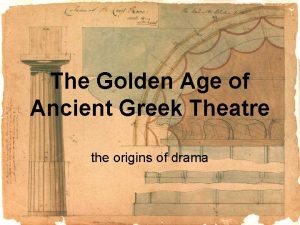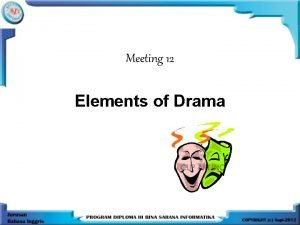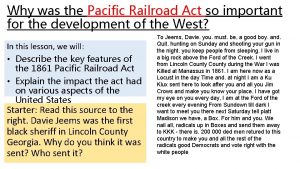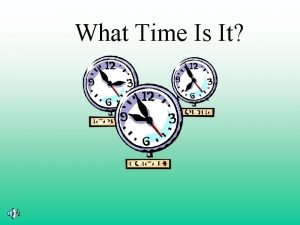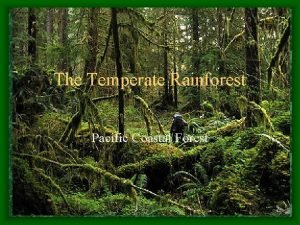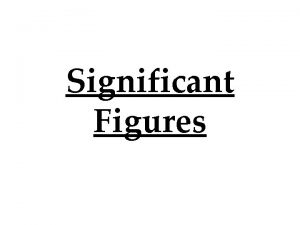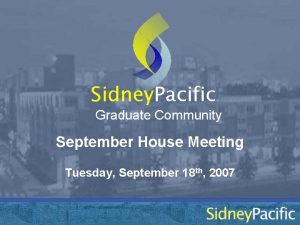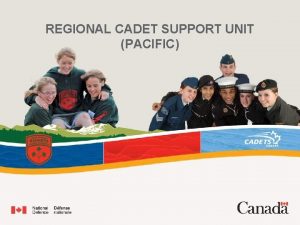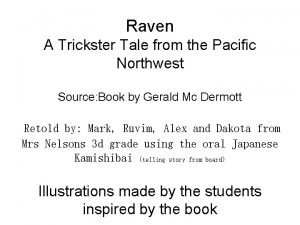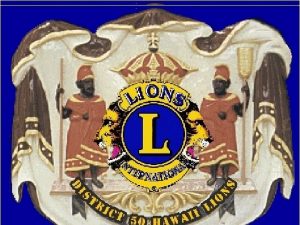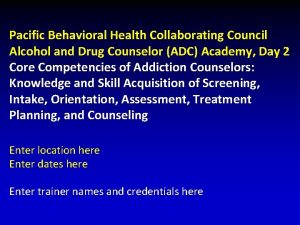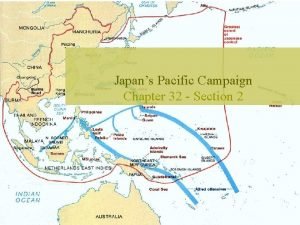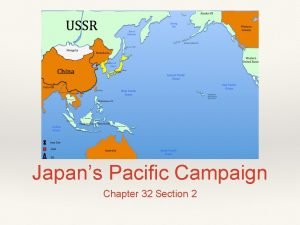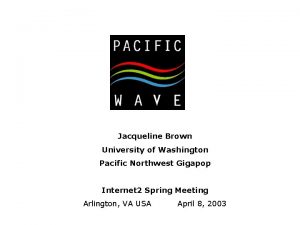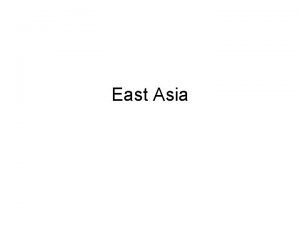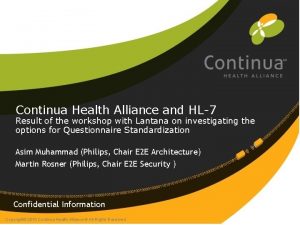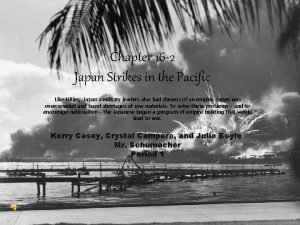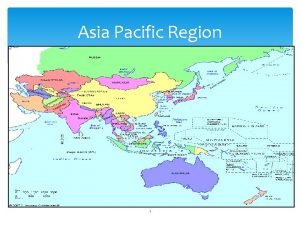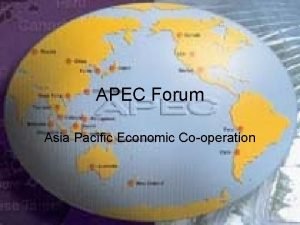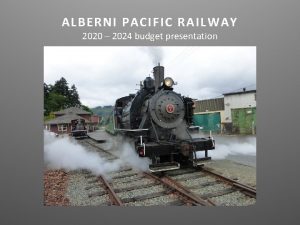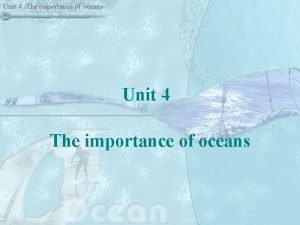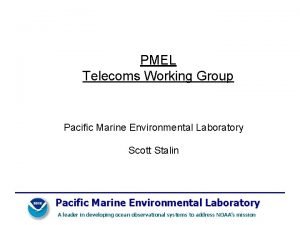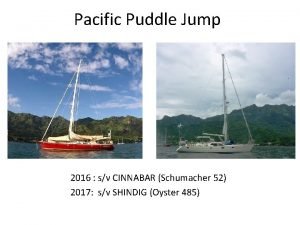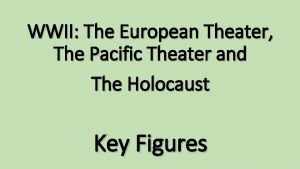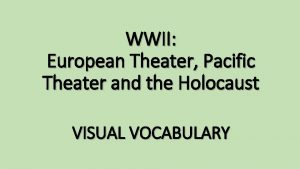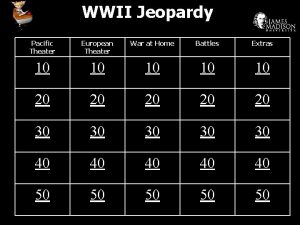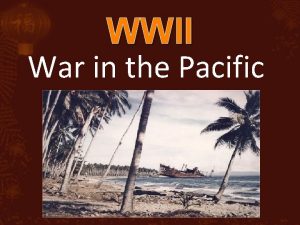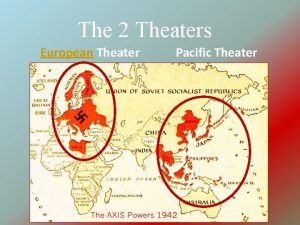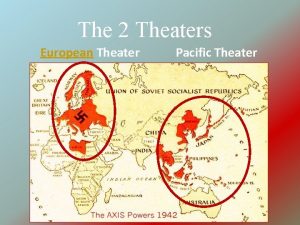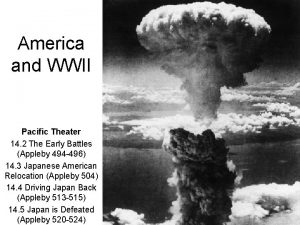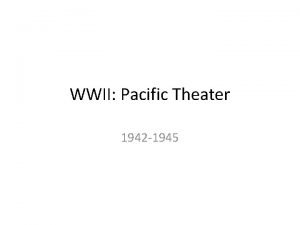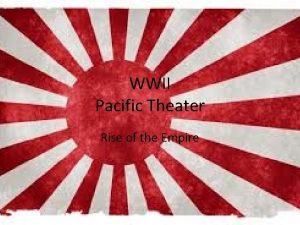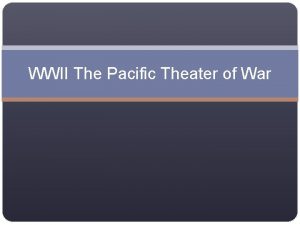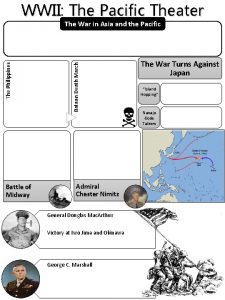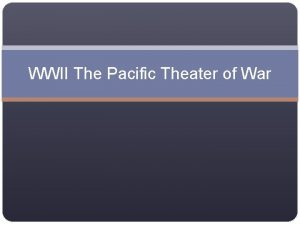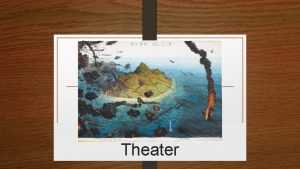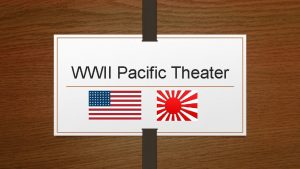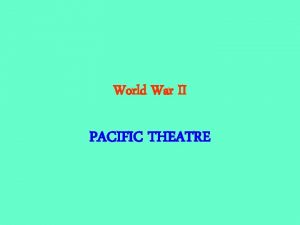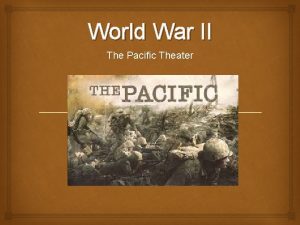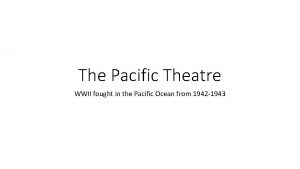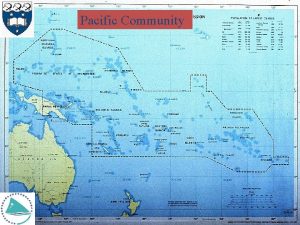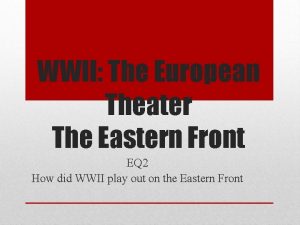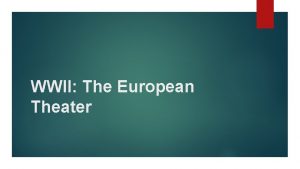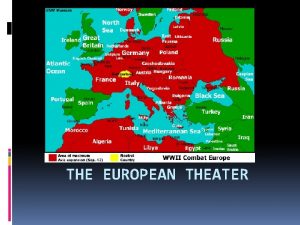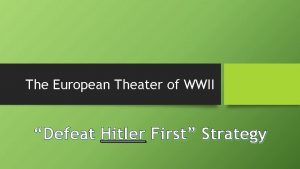WWII The European Theater The Pacific Theater and























































- Slides: 55

WWII: The European Theater, The Pacific Theater and The Holocaust Cause and Effect

LEARNING OBJECTIVES: SS. 912. A. 6. 1 Examine causes, course, and consequences of World War II on the United States and the world SS. 912. A. 6. 2 Describe the United States response in the early years of World War II (Neutrality Acts, Cash and Carry, Lend Lease Act) SS. 912. A. 6. 3 Analyze the impact of the Holocaust during World War II on Jews as well as other groups SS. 912. A. 6. 6 Analyze the use of atomic weapons during World War II and the aftermath of the bombings SS. 912. A. 6. 7 Describe the attempts to promote international justice through the Nuremberg Trials SS. 912. A. 6. 9 Describe the rationale for the formation of the United Nations, including the contribution of Mary Mc. Leod Bethune

World War II Main Idea: • The rise of rulers or dictators in Europe and Asia led to World War II • Germany invaded and quickly conquered many European countries, but later lost the war. • The United States was reluctant at first to fight in WW 2, but supported the Allies and joined them when the U. S. was attacked at Pearl Harbor

World War II: Overview Source http: //diazsocialstudies. org/ahistory_units_2. htm#wwii 1

Causes of World War II Main Causes: • • Nationalism Dictators (Totalitarianism) Failures of the WW 1 peace plan Rise of Fascism in Italy- Mussolini Rise of Fascism (Nazis) in Germany- Hitler Communist Soviet Union- Stalin Military gains control in Japan Anti-Semitism

Causes of World War II Nationalism: • • • A belief that your nation is great Everyone should be loyal to your nation above all else Hope to get more land for your nation.

Causes of World War II Totalitarianism or Dictatorship: • Political system where the state recognizes no limits to its authority • Strives to regulate every aspect of public and private life • All-encompassing propaganda disseminated through the state-controlled mass media • A single party • Control over the economy, regulation and restriction of speech, and mass surveillance • Due to economic depressions and struggles, dictators rose to power and had complete control over its citizens

Causes of World War II Failures of the WWI Peace Plan: • • • Treaty of Versailles caused anger and resentment for Germany It blamed them for starting the war Took away all of their colonies Took away some of their territories to form new nations in Central and Eastern Europe People turned to dictators to help solve economic and social problems they faced

Rise of a Fascist Italy • • • Extreme Nationalism Expanded military Charismatic leader Private property allowed but with strong government control Mussolini wanted to build a new "Roman" Empire Attacked and took Ethiopia. Rise of a Nazi Germany Rise of a Communist • Extreme Nationalism and Soviet Union • • racism Expanded military Forceful leader Private property allowed but with strong government control Anticommunist • • • Created a communist state Wait for a world revolution Revolution by workers Eventual rule by working class State ownership of property

Causes of World War II Japan: • • • Nationalist military leaders took control over the government. Believed they needed more land or living space for their people (just like Hitler). Attacked China (Manchuria) in 1931. Japan wanted an Asian/Pacific Empire rich in natural resources. The United States also had interests to protect in the Pacific (Hawaii, Philippines, etc. ) Tensions rose between when Japan took over new lands and the United States cut off trade (oil) to Japan

Japanese Expansion: Japan began expanding its territory before WW 2 began.

World War II Anti-Semitism A hatred of the Jews. Germans blamed the loss of WW 1 and major economic problems on the Jews. This led to the rise of the Nazis and Hitler to take control of Germany in 1933. After Hitler took power, all non "Aryans" were discriminated against. At first Jews were arrested and put into concentration camps- where many died from disease, starvation, or murdered. • Genocide was their final solution, this was a mass exterminations of Jews and other groups began in 1942 to the end of the war in 1945. • Over 6 million Jews were killed as well as another 5 million other peoples during the Holocaust. • • •


Events Leading To World War II

Germany’s Role in starting WWII Germany violated Treaty of Versailles by: • Building up the military • Sending troops into the Rhineland, a German region that was taken away. • Not paying reparations from World War I • Making an alliance with Austria • Sending troops into Austria, Czechoslovakia, and Poland.

Hitler’s Actions Before WW 2

World War II: American Impact • Most Americans were alarmed by the rise of dictators and conflicts, but did not want to get involved and avoid war at all costs. (isolationism) • Starting in 1935, U. S. signed several "Neutrality Acts. " This banned the sale of arms or loan money to nations at war. • However by 1939, Roosevelt was allowed to provide arms and other supplies to France and Britain to fight Germany ("cash and carry") however, isolationists were not happy. Later this included the Soviet Union.

America Joins World War II • Japan attacked Pearl Harbor, a Naval Base in Hawaii on December 7, 1941. • Over 2, 400 Americans were killed and many wounded. They also destroyed 21 ships and 300 planes. • The next day, the U. S. declared war on Japan • U. S. joins the Allies and fights the Axis powers

Source http: //hcworldwarii. weebly. com/causes-of-wwii. html

U. S. Mobilization For WW II: Creation of War Boards, Taxes, War Bonds • War is expensive and the US needed everyone’s support to help “win the war” • They sold war bonds as investments in the country and in the individuals financial future • For $18. 75 you could buy a $25 War Bond. In 10 years it would be worth $25 • The government would use this money to help finance the costs related to uniforms, weapons, medicine, food, or cost of tanks, planes, ships

U. S. Mobilization For WW II: Selective Training and Service Act of 1940 • Troops were needed to fight • Roosevelt warned, “America stands at the crossroads of its destiny” • Congress passes the Act and created “the draft” • All men aged 18 to 45 were made subject to military service • All men aged 18 to 65 were required to register • A lottery system was developed and called men to service • After Pearl Harbor, 5 million volunteered for the military • After the draft, we had up to 15 million soldiers to help fight the war

U. S. Mobilization For WW II: Women & Minorities Enter the Military • Women joined the military as nurses, drivers, radio operators, etc. but not in direct combat. • Women's Army Auxiliary Corps (WAC), • Women Airforce Service Pilots (WASP) • Women Accepted for Volunteer Military Services (WAVES). • Tuskegee Airmen were a unit of African American pilots that fought in World War II and received more awards then any other unit • Navajo Code Talkers Project used Native Americans and their language to send messages to troops, it is the only code that was not broken during the war • Many minority groups (African , Native, Mexican, Chinese, and Japanese Americans) were in segregated military units and faced discrimination.

U. S. Mobilization For WW II: Atomic Weapons: The Manhattan Project • Nuclear fission was discovered by German Chemists in 1938 • August 1939 Albert Einstein, who had immigrated to the U. S. , wrote to President Roosevelt to warn him that the Nazis were working on an atomic bomb. • The U. S. did not want Germany to have a nuclear bomb first and called for a team to research and develop one in America (Einstein was not part of the team due to security clearance) • Nuclear facilities were built at Oak Ridge, Tennessee and Hanford, Washington • Grew to employ more than 130, 000 people and cost nearly $2 billion

U. S. Mobilization For WW II: The Manhattan Project was a well kept secret In the Summer 1945 the first bomb was developed The Manhattan Project developed 3 bombs The first bomb “the Gadget” was tested in Los Alamos, New Mexico and created a crater 2400 feet across • The second bomb, known as "Little Boy" was detonated over Hiroshima • The final bomb, "Fat Man" was detonated over Nagasaki. • •

Production on the Home Front • With so many men in the military, women had to take over jobs that normally done by men. • Many African Americans moved North for better war-time jobs. • Minorities who were not enlisted were given jobs they could never get before. • However, women and minorities did not get paid as much for doing the same jobs.

Production on the Home Front • These new workers were now making needed supplies to support the war overseas • Automobile plants were changed to produce tanks, planes, boats, and jeeps • Factories changed for war production- bomb parts, shells with explosives, uniforms and gear, etc.

Production on the Home Front • The Emergency Price Control Act (1942) granted the authority to set price limits and ration food/commodities • Rationing was used to make sure there was enough essential goods for the military • They were given coupons or vouchers for scarce products • Advertisements went out to show what you could do to support the war

War’s Impact On The Home Front Racism, Discrimination and the Internment of Japanese Americans • Japanese Americans were placed in "internment" camps due to fears of Japan attacking the U. S. Over 100, 000 Japanese Americans were placed in these camps. • 1943, racial violence and riots happened across the country due to continued discrimination in the North (segregation) as well as for Mexican Americans in California. • German and Italian Americans also faced discrimination and distrust during the war.

Key Events 1930 s Sep 1931 – Feb 1932 Japan invades Manchuria January 1933 Hitler elected Chancellor of Germany September 1935 Nuremberg Laws 1936 German occupation of the Rhineland November 1936 Anti-Comintern Pact (Germany, Japan) June 1937 Japan invades Peking, China December 1937 “The Rape of Nanking”; Japan kills 200, 000 Chinese civilians Mar-Sept 1938 “Anschluss” and the Munich Peace Agreement May 1939 Pact of Steel (Germany, Italy) August 1939 German-Soviet Nonaggression Pact September 1939 Germany invades Poland; France and Great Britain declare war November 1939 “Kristallnacht”: Night of the Broken Glass (Jewish property destroyed

Key Events 1940 - 1943 May 1940 Germany invades France May – June 1940 Battle of Dunkirk June 1940 France Surrenders to Germany July-Sept 1940 “Battle of Britain” German invasion of Britain fails September 1940 Tripartite Pact (Germany, Italy, Japan) June 1, 1941 Germany invades USSR June 1941 Concentration Camps December 7, 1941 Japanese attack Pearl Harbor; United States enters the war December 1941 Japan attacks Philippine Islands May 1942 Battle of Coral Sea June 1942 Battle of Midway; Turning point in the Pacific Theatre July ‘ 42 – Feb. ‘ 43 Battle of Stalingrad; Turning point on the Eastern Front

Key Events 1944 - 1949 June 6, 1944 D-Day: “Operation Overlord”; Allied Invasion of Normandy December 1944 Battle of the Bulge Feb – Mar 1945 Battle of Iwo Jima April 1945 FDR dies; Mussolini executed; Hitler commits suicide May 8, 1945 V-E Day: Germany surrenders Aug 6 & Aug 9 1945 U. S drops atomic bombs on Hiroshima and Nagasaki August 14, 1945 V-J Day: Japan surrenders October 1945 Creation of the United Nations (UN) 1945 – 1949 Nuremberg Trials May 1948 Creation of Israel April 4, 1949 North Atlantic Treaty Organization formed (NATO)

MAIN EVENTS OF THE WAR (1941 -1945):

WWII Events • June 1941: Germany attacked Soviet Union. • Germany conquered a lot of land with the goal of getting much needed oil. • Dec. 1942: Germany was defeated in Stalingrad and had to slowly retreat, losing all the land they conquered to Soviet Union. • Dec. 1941: U. S entered the war after Japan attacked Pearl Harbor.

WWII Events

WWII Events • As a result of invading Austria, Czechoslovakia, and Poland; France and Britain declared war on Germany. • Soviet Union/Germany “Nonaggression Pact" agreed to not attack each other (even though they were bitter enemies) if Hitler attacks Poland with the promise to divide Poland between them. • Attacked Poland was taken over. • At first France/Britain and Germany did not fight each other (about 9 months). • Then in 1940, Hitler launched a surprise attack conquering Denmark, Norway, Netherlands, Belgium, and finally France by June 1940. • Germany began The Battle of Britain but could not defeat Britain.

WWII Events In The Pacific • Japan won early victories at first, but began to lose to the Americans (Allies) • At the Battle of Midway, Japan lost a lot of their navy. • The Allies began "island hopping" winning one island at a time; moving closer to Japan. • As Japan lost most of their navy fleet and planes, they began to a new tactic • They used Kamikaze pilots who flew their planes on a suicide mission into major battleships or aircraft carriers.

WWII Events • • • Allies and Axis fight in North Africa in 1942 -43. D-Day: June 1944 - Allies invade France to defeat the Germans April 1945 Allies invade Italy, Mussolini is killed by Italian Partisans April 1945, Soviet Union is in Germany (Berlin) and has taken over Eastern Europe. Britain and the United States are in Western Germany completely surrounded.

WWII Events In The Pacific • By June 1945, the Allies were ready to invade Japan. • By this time, Japanese were fierce fighters; most committing suicide rather than surrendering. • It was predicted that over 1 million Americans lives and millions of Japanese could be lost in the invasion. • The U. S. was developing an atomic bomb. • This 1 bomb can destroy a large city. To avoid invading Japan and face many predicted deaths, it was decided to use the new atomic bomb and destroy Hiroshima and Nagasaki. • The atomic bomb ends the war.

WWII Ends • Surrender on all fronts and the world starts on the road to recovery.

Effects of WW 2 Social Effects • “Rosie the Riveter”: Women gain a new independence that leads to the Feminist Movement of the 1960 s • U. S. Military becomes integrated July 26, 1948 • Baby Boom: New births after the war made up 40% of the population • Refugee Crisis: 20 million people lose their homes as a result of the war. • Nuremberg Trials: For the first time, military leaders are put on trial for crimes against humanity (War Crimes) • Increase in scientific and technological development: Rocketry and Nuclear Physics

Effects of WW 2 Political Effects • Superpowers are formed: The war left European world powers extremely weakened, leaving the U. S. and USSR the only remaining global powers • The failures of Fascism led to a rise in communist regimes. • European colonial domination came to an end. • United Nations is formed October 24, 1945 in order prevent future world wars from ever happening again. • The Nation of Israel is formed May 14, 1948 • North Atlantic Treaty Organization (NATO) is formed as a military alliance to safeguard the security and freedom of its members.

Effects of WW 2 Economic Effects • European governments were heavily in debt due to loans from the U. S. • World Trade Organization (WTO) is established to regulate and insure free trade • The World Bank is formed to provide loans to developing countries and help reduce poverty • International Monetary Fund (ITF) is created to prevent future depressions by stabilizing exchange rates

Results & Consequences Of WWII: Of WWII • • • The Holocaust The Nuremberg Trials War Conferences: Teheran, Yalta, & Potsdam Allied Occupation of Germany U. S. Occupation of Japan Formation of the United Nations

Results & Consequences Of WWII: Results & Consequences Of WWII Source https: //en. wikipedia. org/wiki/World_War_II

Results & Consequences Of WWII: The Holocaust • The horrors of the Holocaust and “the final solution” is revealed to the rest of the world. • The world learns of the millions of people sent to concentration camps and the genocide that took place

Results & Consequences Of WWII: WWII The Nuremberg Trials • A series of trials held by the Allied Forces • For justice to the Holocaust victims and war crimes, many Nazi German war criminals were put on trial (Nuremberg War Trials) and were punished to promote international justice.

Results & Consequences Of WWII: WWII War Conferences- Teheran 1943 • First meeting with Stalin, Churchill and Roosevelt • They had one goal, the destruction of Germany and Japan • There would be a Soviet “sphere of influence” in Eastern Europe and a capitalist on in Western Europe • They discussed what each country would commit to in the war effort • They did not come to agreement on what to do with Germany

Results & Consequences Of WWII: Results & Consequences Of WWII War Conferences-Yalta February 1945 Second meeting where the leaders began planning for the future, they agreed upon: • Establish a United Nations Organization • Divide Germany into occupation zones for each power • Berlin (in the Russian zone) also to be split into zones • Similar arrangements for the occupation of Austria • Free elections in Eastern Europe • Stalin would join the war against Japan 3 months after Germany’s defeat • Bessarabia and the Baltic States of Lithuania, Latvia and Estonia (seized by Stalin in 1939) would become part of the USSR

Results & Consequences Of WWII: Results & Consequences Of WWII War Conferences Potsdam July 1945 • The third meeting, this time with Stalin, Truman, and Attlee • Germany had surrender at this point and the three continued to agree on the following: • Germany would be run by a Control Council made up of the four military commanders of the four zones • Germany had “chance to. . . rebuild its life on a democratic and peaceful basis” • Nazi leaders were to be put on trial • Reparations would be set up

Results & Consequences Of WWII: Results & Consequences Of WWII U. S. Occupation of Japan 1945 -1952 • Led by General Douglas A. Mac. Arthur, enacted widespread military, political, economic, and social reforms for Japan • Japan adopted a democratic form of government making their emperor a figure head

Results & Consequences Of WWII: Results & Consequences Of WWII Allied Occupation of Germany • The four powers divided Germany into four occupation zones • American, British, French and Soviet Zones were created • Each country oversaw their zone and set up policies

Results & Consequences Of WWII: Results & Consequences Of WWII Formation of the United Nations • As the war ended, the United Nations was established and replaced the League of Nations. • April 1945, people from 50 nations met to establish a new peacekeeping body. • Their mission was to stop wars between countries and provide a forum to discuss issues, open dialogue • June 1945, people from these countries signed a charter as an international organization to keep world peace. Mary Mc. Leod Bethune and Eleanor Roosevelt was involved in developing the charter.

Additional Resources http: //www. cpalms. org/Public/Preview. Resource. Url/Preview/121788 America on the Sidelines: The U. S. and World Affairs 1931 -1941 interactive time line http: //www. cpalms. org/Public/Preview. Resource. Url/Preview/155062 Crash Course U. S. History: World War II - Part 1 video 15 minutes http: //www. cpalms. org/Public/Preview. Resource. Url/Preview/155067 Crash Course U. S. History: World War II - Part 2 video 16 minutes, looks at changing roles and policies http: //www. cpalms. org/Public/Preview. Standard/Preview/3370 Reading Like a Historian: Atomic Bomb, informational text, look at what happened at Hiroshima http: //www. cpalms. org/Public/Preview. Resource. Url/Preview/59679 Japanese American Internment: Evaluating Primary Sources, primary source materials http: //www. cpalms. org/Public/Preview. Resource. Url/Preview/46185 Understanding the Decision to Drop the Bomb on Hiroshima and Nagasaki, informational text

Additional Resources https: //www. youtube. com/watch? v=myjz 2 UUd. NVA 25 Things You Don't Know About WW II 5 minute video https: //prezi. com/iysuvhf 2 jfrf/5 -ways-hitler-violated-the-treaty-of-versailles/ 5 Ways Hitler Violated the Treaty of Versailles, a Prezi presentation http: //www. youtube. com/watch? v=so. Zyqrb. KYWw video Turning Points in History: Hitler (5 parts) http: //www. history. com/this-day-in-history/franklin-roosevelt-approves-military-draft article “on this day in history, The Selective Service Act http: //www. youtube. com/watch? v=5 KPCl 9 wh 1 G 4 World War II: The Lost Color Archives (1/5) http: //www. youtube. com/watch? v=d. GGs. QR 1 y 1 S 0 Why the US Entered WW II video 43 minutes

Additional Resources http: //www. youtube. com/watch? v=Ogk. Na. K 6 fvi. A Japanese American Internment During WW II video 18 minutes http: //www. nationalww 2 museum. org/learn/education/for-students/ww 2 -history/take-acloser-look/war-bonds. html? referrer=https: //www. google. com/ Take a Closer Look at War Bonds article with primary source documents http: //www. history. com/news/hungry-history/food-rationing-in-wartime-america article on rationing during WWII http: //www. youtube. com/watch? v=3 g. Qaw. PAs. Zw. I WW II & the Holocaust video 6 minutes https: //quizlet. com/subject/world-war-ii/ variety of quizzes and flashcards on WWII
 Pacific theater timeline
Pacific theater timeline Fdrs quarantine speech
Fdrs quarantine speech Greek theater vs modern theater
Greek theater vs modern theater Military words for letters of the alphabet
Military words for letters of the alphabet Advances in technology during wwii
Advances in technology during wwii The nye committee definition
The nye committee definition Wwii picture
Wwii picture Wwii picture
Wwii picture Wwii study guide
Wwii study guide Effects of wwii
Effects of wwii Color tv started
Color tv started 1500 dead in hawaii congress votes war
1500 dead in hawaii congress votes war Causes of wwii
Causes of wwii Map of german aggression wwii
Map of german aggression wwii Wwii
Wwii Could wwii have been prevented
Could wwii have been prevented Wwii test review
Wwii test review Zoot suit riots apush
Zoot suit riots apush University mobility in asia and the pacific
University mobility in asia and the pacific Statistical institute for asia and the pacific
Statistical institute for asia and the pacific Australia the pacific realm and antarctica
Australia the pacific realm and antarctica Imperialism in southeast asia and the pacific
Imperialism in southeast asia and the pacific Role of chorus in greek tragedy
Role of chorus in greek tragedy What are the 12 elements of drama?
What are the 12 elements of drama? The pacific railroad act of 1862
The pacific railroad act of 1862 Where does the pacific time zone start
Where does the pacific time zone start Pacific northwest temperate rainforest
Pacific northwest temperate rainforest All nonzero digits are significant.
All nonzero digits are significant. Sidney pacific mit
Sidney pacific mit Schaeffler asia pacific
Schaeffler asia pacific Serial killers pacific northwest
Serial killers pacific northwest Regional cadet support unit pacific
Regional cadet support unit pacific Raven: a trickster tale from the pacific northwest
Raven: a trickster tale from the pacific northwest Pacific lions club
Pacific lions club Pacific university dental hygiene
Pacific university dental hygiene Ring of fiee
Ring of fiee Pacific behavioral health
Pacific behavioral health Azusa pacific university school of nursing
Azusa pacific university school of nursing Japan's pacific campaign chapter 32 section 2
Japan's pacific campaign chapter 32 section 2 Chapter 32 section 2 japan's pacific campaign
Chapter 32 section 2 japan's pacific campaign Pacific northwest gigapop
Pacific northwest gigapop Asia pacific bmi
Asia pacific bmi Pacific rim 1
Pacific rim 1 Pacific rim2 cda
Pacific rim2 cda Japan strikes in the pacific
Japan strikes in the pacific Asian american inventors
Asian american inventors Asia pacific region
Asia pacific region Apec forum
Apec forum Alberni pacific railway
Alberni pacific railway Acn pacific
Acn pacific Martiap
Martiap Five importance of ocean to man
Five importance of ocean to man Thought patterns for a successful career pacific institute
Thought patterns for a successful career pacific institute Pacific marine environmental laboratory
Pacific marine environmental laboratory Sv cinnabar
Sv cinnabar Pacific northwest college credit
Pacific northwest college credit
